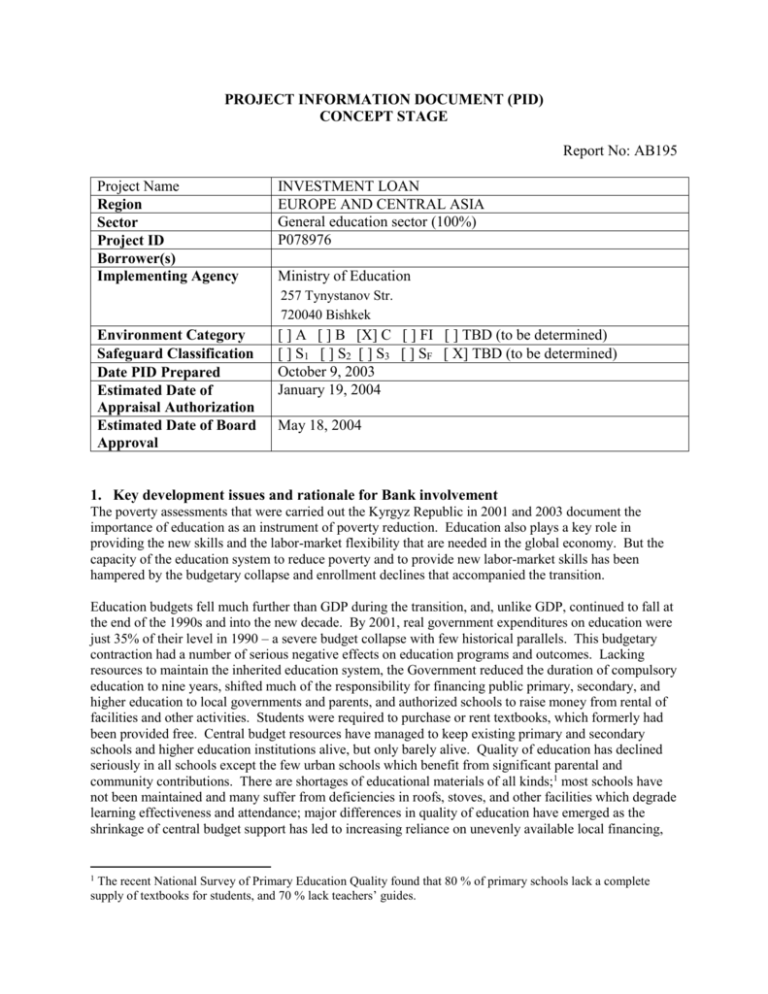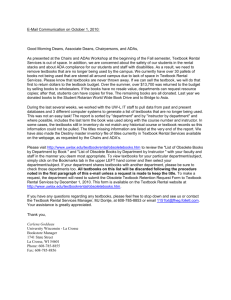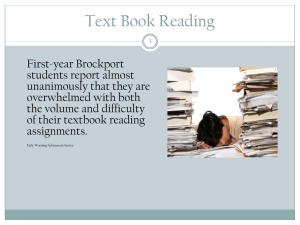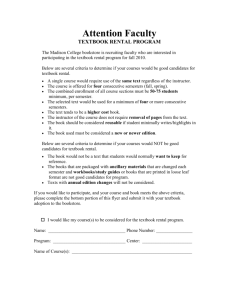project information document (pid) - Documents & Reports
advertisement

PROJECT INFORMATION DOCUMENT (PID) CONCEPT STAGE Report No: AB195 Project Name Region Sector Project ID Borrower(s) Implementing Agency INVESTMENT LOAN EUROPE AND CENTRAL ASIA General education sector (100%) P078976 Ministry of Education 257 Tynystanov Str. 720040 Bishkek Environment Category Safeguard Classification Date PID Prepared Estimated Date of Appraisal Authorization Estimated Date of Board Approval [ ] A [ ] B [X] C [ ] FI [ ] TBD (to be determined) [ ] S1 [ ] S2 [ ] S3 [ ] SF [ X] TBD (to be determined) October 9, 2003 January 19, 2004 May 18, 2004 1. Key development issues and rationale for Bank involvement The poverty assessments that were carried out the Kyrgyz Republic in 2001 and 2003 document the importance of education as an instrument of poverty reduction. Education also plays a key role in providing the new skills and the labor-market flexibility that are needed in the global economy. But the capacity of the education system to reduce poverty and to provide new labor-market skills has been hampered by the budgetary collapse and enrollment declines that accompanied the transition. Education budgets fell much further than GDP during the transition, and, unlike GDP, continued to fall at the end of the 1990s and into the new decade. By 2001, real government expenditures on education were just 35% of their level in 1990 – a severe budget collapse with few historical parallels. This budgetary contraction had a number of serious negative effects on education programs and outcomes. Lacking resources to maintain the inherited education system, the Government reduced the duration of compulsory education to nine years, shifted much of the responsibility for financing public primary, secondary, and higher education to local governments and parents, and authorized schools to raise money from rental of facilities and other activities. Students were required to purchase or rent textbooks, which formerly had been provided free. Central budget resources have managed to keep existing primary and secondary schools and higher education institutions alive, but only barely alive. Quality of education has declined seriously in all schools except the few urban schools which benefit from significant parental and community contributions. There are shortages of educational materials of all kinds;1 most schools have not been maintained and many suffer from deficiencies in roofs, stoves, and other facilities which degrade learning effectiveness and attendance; major differences in quality of education have emerged as the shrinkage of central budget support has led to increasing reliance on unevenly available local financing, 1 The recent National Survey of Primary Education Quality found that 80 % of primary schools lack a complete supply of textbooks for students, and 70 % lack teachers’ guides. parental contributions, tutoring, supplementary financing through rental of premises and non-educational activities. Education quality has also been affected by the inconsistent roles of central and local governments for delivery of education under the ongoing decentralization process. Local governments are meant to be responsible for managing and financing primary and secondary schools, but they cannot perform this role effectively because of revenue shortages and the constraints imposed by the Ministry of Education and Culture on teacher and principal recruitment. These central constraints are intended to prevent erosion of education quality through excessively large class sizes. But they are an ineffective instrument of quality assurance. Class sizes are, if anything, too small in most schools. And the experience of the past decade has shown that these input controls are not effective instruments for quality assurance. Quality differences among schools have grown as a result of actions taken to diversify education financing and differences in the capacities of communities and households. Social assessments carried out by UNICEF confirm that the imposition of textbook rental charges and informal school fees has been a deterrent to school attendance for poor families. Declining quality results mainly from budgetary neglect, resulting in depleted stocks of textbooks and other educational materials, in an underpaid and demoralized teaching force, and in physical deterioration of schools. The increasing reliance on formal and informal parental contributions to meet essential school needs also results in a more unequal distribution of education quality. Large differences have emerged in teaching conditions and educational outcomes among oblasts and between urban and rural schools. A recent national assessment primary school facilities and student achievement documented the very diverse situation of primary schools and student achievement. Four times as many fifth-grade students in Batken oblast and three times as many students in Talas oblast received mathematics scores in the lowest category as in Bishkek; 70% more students in Bishkek received scores in the highest category than in Batken oblast.2 Consistent differences in assessment results were also recorded between rural and urban schools across oblasts, with rural students more than twice as likely as urban students to score in the lowest category on the mathematics assessment. Education is a central theme both of the current CAS and the National Poverty Reduction Strategy (NPRS). Other donors – notably, the Asian Development Bank and USAID – are supporting teacher training and improvements in curricula, education management, and textbooks. These are valuable interventions. But in many cases, they are not achieving their full potential because of flaws in underlying policy. Three unresolved policy questions are of particular importance for the quality of rural schooling: a) deficiencies in the financing formula for primary and secondary education which systematically underprovide needs of rural schools and fail to provide an incentive for efficiency improvements, b) the absence of incentives for teachers to upgrade their skills and improve their classroom teaching performance, and c) deficiencies in the textbook rental scheme which lead to many children not having textbooks. All three of these policy areas involve a combination of educational and financial considerations. The World Bank is uniquely situated to help in these areas because its dialogue on macro policy and budget issues, as well as educational issues situates it to help broker improved policy. The process of policy improvement has already started under the Governance Structural Adjustment Credit, in which the Government has agreed to revise the formula for decentralized financing of primary and secondary schools. The proposed Education Quality Improvement Project – formerly referred to as the Rural Education Project -- has been formulated to respond to this request. The project as currently envisioned would comprise a combination of generic policy actions which would benefit all of Kyrgyzstan’s 2,000 primary 2 Monitoring Learning Achievement: National Survey of Primary Education Quality, Ministry of Education and Culture, UNICEF, UNESCO, and the Center for Opinion Studies and Forecast, Bishkek, 2001. and secondary schools, as well as actions targeted to rural schools -- particularly in areas with the lowest learning achievement. Generic actions are crucial to the project’s objective of improving rural schools. (Seventy-one percent of primary and secondary enrollments are in rural areas.) The proposed project aims to make better use of existing education resources -- the Government’s own resources, parental and community contributions, and donor resources -- by improving the transparency of education resources and communities’ participation is setting priorities at the school level. The proposed policy actions under the project would leverage and complement other education resources in several ways. For example, USAID is supporting a program of teacher training which suffers from the structural problem that while it will offer some very valuable training to improve teaching practices, there are currently no incentives for teachers either to avail themselves of these opportunities or to apply the improved teaching methods in their daily teaching. The policy actions proposed under the project are intended to help provide these incentives. Another example involves textbook provision. A large ADBfinanced project has supported the development and provision of textbooks for primary and secondary schools. This effort has materially improved the overall availability of textbooks. But it has not addressed the problem of student access to books that are available in schools. Even in schools which have received new textbooks under the project, some children still lack textbooks because their families are too poor to pay the modest rental charges under the current textbook rental scheme. Survey results have confirmed that this phenomenon contributes to lower school attendance, as well as having obvious effects on what students learn. Another problem that affects the development impact of donor assistance for textbook publishing involves the current authorship and approval process, and its implications for the quality of textbook content. The Academy of Education’s current roles of textbook authorship and textbook approval involve an intrinsic conflict of interest. The resulting lack of genuine competition limits the quality of textbook content. Current procedures of textbook publishing are also inefficient because they select printers and distributors on a non-competitive basis. To address these problems, the proposed Education Quality Improvement Project would seek fundamental changes in the textbook authorship, approval, and publication process, as well as in the textbook rental scheme. Instead of peer review, the team requested a Quality Enhancement Review (QER) to provide comments and recommendations on the team’s draft Project Concept Note (PCN) prior to the formal PCN review. The QER panel included two Bank experts and one outside expert – all with extensive experience in design and implementation of education projects with similar objectives and focus. Involvement of the outside expert was also intended to capitalize on his perspective as the manager of the most important current donor-financed program in education quality improvement in the Kyrgyz Republic. The full report of the QER’s findings and recommendations is being distributed separately to participants of the Project Concept Note Review. The proposed project design responds to the main recommendations of the QER panel, particularly to its principal recommendation ”that the project be prepared relatively quickly to address the acute problems”, … and to address the more chronic problems in basic education quality and coverage under a subsequent operation. The policy actions to be supported under the project would address many of the findings and recommendations of 2004 World Development Report, including providing instruments (national student assessment and school development plans) and incentives (teacher professional development) for improved teaching performance, as well as the means (in the form of improved educational resources) for students to benefit from improved teaching performance. 2. Proposed objective(s) The primary objective of the proposed project is to improve the coverage and quality of primary and secondary education, with improved coverage defined as improved school attendance in grades 1 through 11, and improved quality defined as improved student learning achievement throughout primary and secondary education (grades 1 through 11). The project’s secondary objective is to make primary and secondary schools more accountable to the local community and to involve parents more actively in the activities of schools. (International research has consistently found that parental involvement in schools is positively associated with educational outcomes, including school attendance and student achievement.) 3. Preliminary description As currently envisioned, the proposed project comprises four components: A. Textbooks. This component would finance: a) publishing and distribution of priority textbooks – for the most part consisting of titles for which acceptable manuscripts are already available, b) improving textbook publishing by starting the process of separating authorship and selection functions, introducing competition in the authorship of new titles, and allowing private-sector publishers to compete with the Academy of Education for publication of textbooks, c) author training and other actions to improve the quality of textbook content, and d) the development and introduction of an improved textbook rental scheme with clear and sustainable objectives and with adequate provision for ensuring that household’s inability to pay textbook rental charges does not prevent children from having textbooks. The component would include a Letter of Government Policy on Textbook Production which confirms the Government’s commitment to the medium-term policy changes in the textbook production process. The project Grant Agreement would also include assurances that rental charges would not prevent any project-financed textbooks from being fully available to students. This could be either through a covenant requiring adoption of the new rental scheme as a condition for procurement, or through other enforceable assurances. B. Teaching and Learning Materials. This component would finance the provision of educational materials to all primary and secondary schools through a participatory, demand driven process. The amount available to schools would be set under a formula which favors smaller, remote, and poorly equipped schools. An educational materials fair approach – which has been successfully used in other ECA education projects -- is envisioned as the mechanism for schools to select educational materials which are relevant to their particular needs. Parents and local government representatives would participate in the selection of educational materials. This would help jump-start the collaboration and local ownership which was intended under the decentralization policy but which, for the most part, has not been achieved. C. Targeted School Grants for Improved Teaching and Learning. This component would be provided to selected low-performance schools to support the preparation and implementation of school development programs. This activity is intended to strengthen teaching skills and to support activities which address schools’ teaching and learning needs. School development programs would be prepared, implemented, and monitored collaboratively by the school and the local community. Each program would start with a statement of educational objectives and an action plan for achieving them, including specific roles for the principal and for each teacher. It would also need to include an assessment of needs for improving teaching skills and to propose appropriate training to meet those needs. In addition to training of principals and teachers, the component could finance a broad range of actions to address educational needs of the school – including purchase of more educational materials than are provided under the Teaching and Learning Materials component, measures such as provision of school lunches, heating fuel, school materials, or clothing to address the income constraints of poor students, or actions to improve the living conditions of teachers if these are agreed by parents and the community as important for attracting and retaining qualified teachers. As currently envisioned, this component would be targeted to selected schools in two oblasts with the poorest overall educational performance – prospectively, Talas and Batken. Schools would be selected for participation based on performance and poverty criteria. A competitive process is not proposed for selection of schools because schools which are most in need of assistance are typically the least capable of assessing their needs and developing a credible plan to address them. Experience with school funds in other countries demonstrates the importance of close and continuous support to help schools and communities understand and apply the concept of school development programs. The component would include financing for contracted outreach services to assist the selected schools and their communities to prepare and implement school development programs . D. Monitoring and Evaluation. This component would finance: a) the development of student assessment as an instrument for improved quality of primary and secondary education, including participation in the next round of the PISA learning assessment organized by the OECD, b) monitoring and evaluation of the project, including commissioned studies and surveys of the educational impacts of the project within the larger context of other actions affecting primary and secondary education, including the education projects supported by the Asian Development Bank, USAID, and other donors, and c) development of the Ministry’s professional capacity for strategic planning. 4. Safeguard policies that might apply [Guideline: Refer to section 5 of the PCN. Which safeguard policies might apply to the project and in what ways? What actions might be needed during project preparation to assess safeguard issues and prepare to mitigate them?] 5. Tentative financing Source: BORROWER/RECEPIENT IDA GRANT FOR DEBT VULNERABLE Total 6. Contact point Contact: Michael T. Mertaugh Title: Lead Education Economist Tel: (202) 458-5071 Fax: Email: Mmertaugh@worldbank.org ($m.) 0 15 15







